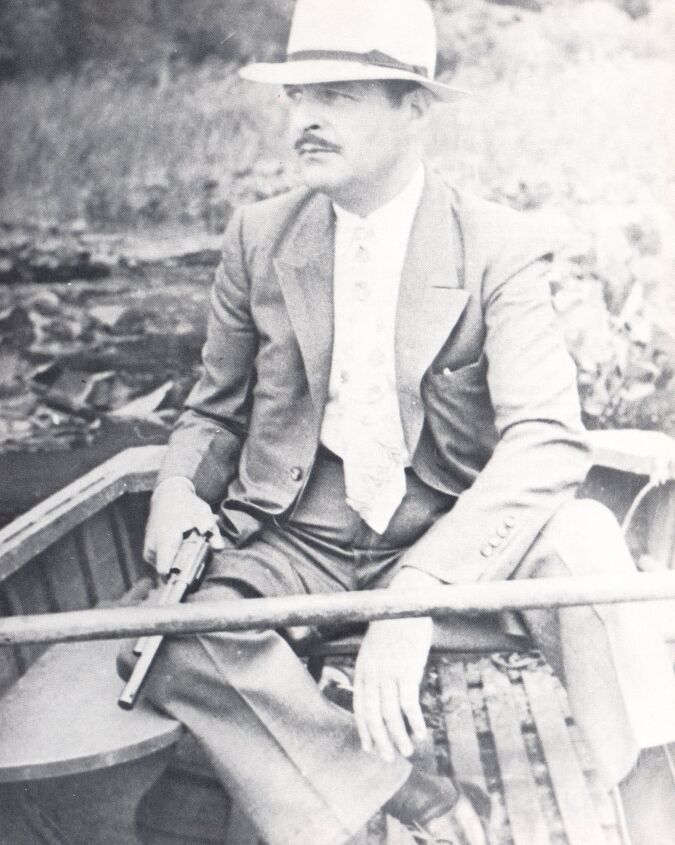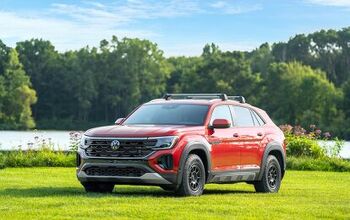What's Wrong With This Picture? Alan Leamy's Spinning Faster Than A Supercharged Model J Over the "Tom Mix" Duesenberg Edition

The third worst thing about this car is the fact that it’s known as the “ Tom Mix Duesenberg” though western actor Tom Mix had apparently had absolutely nothing to do with it. That was a ginned up provenance by a former owner of the car. The second worst thing would be that somebody thought that the car pictured above looked better than the Murphy built Beverly Berline body styled by Gordon Buehrig pictured here:
Now I understand that in the late 1940s or early 1950s, when the Murphy body was removed and replaced with an amalgam of Buick, Olds, Plymouth and Texas longhorn parts, a body designed in the early 1930s might look a bit old fashioned. To each their own and all. Car owners have every right to turn their ride into a testament to their own poor taste – it’s rather amazing what some people who claim to love Corvettes will do with fiberglass – but c’mon, do you really think that most people circa 1950 would look at the results and say, “yeah, I think that’s an improvement”? Still the rebody isn’t the worst thing about this car, it’s the fact that underneath all that that pastiched together kitsch is a genuine Duesenberg, arguably the most esteemed prewar American car ever made. It gets better, or worse, the real Duesey wears engine number J-462, so it’s a Model J, the peak of Duesenberg’s perfection. Just to clarify, the headline uses some literary license, and this is not one of the supercharged SJ models.
Even without the fact that it’s a sow’s ear made out of a silk purse, there are so, so many things wrong with this car. To borrow a term from Sajeev Mehta, there’s enough venom in this thing to kill. That malignant growth on the back deck alone is enough to make you wonder just what kind of person would look at that and say, “Yeah, that looks goood, I like it!” and then get out their checkbook. There is not a single sense of line or proportion anywhere on the car and we haven’t even gotten to the air-cooled-Franklin-swallowing-a-bullet-nosed-Studebaker styled grille yet. What lines there are fight with each other shouting, “look at me, not him!”. Come to think of it, the Boss Hogg style bull horns are the least objectionable thing about this thing. It’s the hot mess of hot messes.
J-462 has also been passed around the Duesenberg collecting community a bit, finally ending up in the collection of deceased Texas tobacco and breast implant litigator, billionaire John O’Quinn. After all a Model J chassis and engine is still worth nicely into the six figures, nobody’s going to sell it for scrap metal. Still, it failed to meet reserve at a Bonham’s auction last year with a $400K-$600K pre-auction estimate and now the O’Quinn estate is offering it with no reserve at Worldwide Auctioneers‘ May 5, 2012 auction, where it has been given a $400K-$500K estimate.
Reportedly, the original Beverly Berline body still exists somewhere in Virginia. I suppose that a purist might buy the car, track down the original Murphy built body, and restore it to better than new condition. I can understand that, but the car’s already no longer original (though the auction catalog says that J-462 is one of the more original Model J engines), one might as well go the custom route, though hopefully a different path than taken by the original customizer.
Alan H. Leamy Jr. had a crippled leg, from polio, and he compensated with a fine sense of sartorial style. He was an avid outdoorsman and collected firearms.
Much as I understand the purist’s motivations, if I could afford it, I’d do something a bit different, after removing the existing body and loaning it to the Museum of Kitsch to preserve it as a cautionary lesson. One of the most talented and influential but least well known American automotive stylists was Alan H. Leamy Jr. He died at the age of 32 in 1935, which explains his obscurity, but Leamy was undoubtedly one of the greats, designing two of the greatest automobile designs ever, the L-29 Cord and the Auburn [boat tailed] Speedster and having a hand in a third masterpiece.
Alan Leamy at work in the Auburn design studio. Those studios have been preserved in the Auburn Cord Duesenberg Automobilie Museum.
Behind a clay model of Gordon Buehrig's Cord 810 is the same drafting table used by Alan Leamy and Buehrig. Note the same curtains on the windows.
As a designer, Leamy was completely self-taught, with a range of knowledge and skills that continued to amaze his associates. His resume includes being hired by both E.L. Cord and Harley Earl on the strength of his portfolio. He was held in the highest regard by other designers. When Gordon Buehrig was brought on to the Auburn team by Errett Cord, he declined to restyle Leamy’s design for the Model J’s signature grille and front end, saying that you don’t mess with perfection.
As Auburn faced increasing financial straits during the Great Depression and as Buehrig was given increasing responsibilities, Leamy got restless and started looking for another job. Enthused with the notion of front wheel drive from his work on the Cords, he showed Packard a proposal for a FWD Packard, but Alvan Macauley, who ran Packard, thought it was “too extreme”. When Leamy approached Harley Earl about a job at GM’s Art and Colour styling department, Earl hired him on the spot, and within months named him head of styling for the LaSalle brand. Tragically, Leamy, who survived polio as a child and never was in great health, died of a blood infection caused by a medical injection shortly thereafter. Leamy did, however, leave a legacy and not just his designs that made it to production. The Leamy archive at the Auburn Cord Duesenberg Automobile Museum includes scores of Leamy drawings, many of them of custom body proposals for Duesenbergs, Cords and Auburns that never got made.
Leamy's design patent for the Cord L-29. He took full advantage of the FWD Cord's low height.
Earlier this year a couple of interesting “classic” cars from the Milhous collection crossed the auction block. They were somewhat controversial because they were Cadillac V-16s that had never actually been built in the classic era. Master Packard restorer Fran Roxas found a couple of designs in Fleetwood’s catalog of custom bodies that he admired, but apparently those exact Cadillacs had never been ordered. So working with designers Strother MacMinn and Dave Holls, using original V-16 chassis, Roxas made one-of-none versions of the 5859 Custom Dual Cowl Phaeton, and the 5802 Custom Roadster. Each sold for right around a million dollars. Roxas is one of the world’s master automotive craftsman. His last project was the Packard Myth, his first custom car, which was a Great Eight finalist for the Ridler Award at the 2011 Detroit Autorama, the custom world’s most prestigious award. Making the Great Eight first time out of the box is a great accomplishment. If there’s one person to build a what-if prewar classic, it’s Roxas.
We don’t know who designed and fabricated the body currently on J-462. I think we can safely say that whoever did do it didn’t have the talent and taste of Alan Leamy and Fran Roxas. I don’t have a problem, really I don’t, with the then owner of this Model J doing what he wanted to do with his own property. It offends me aesthetically and think it was an indignity to the Duesenberg, but property rights are important. If J-462 was my property, though, I’d hire Mr. Roxas to rebody it with one of Alan Leamy’s as yet unbuilt designs.
Ronnie Schreiber edits Cars In Depth, a realistic perspective on cars & car culture and the original 3D car site. If you found this post worthwhile, you can dig deeper at Cars In Depth. If the 3D thing freaks you out, don’t worry, all the photo and video players in use at the site have mono options. Thanks – RJS

Ronnie Schreiber edits Cars In Depth, the original 3D car site.
More by Ronnie Schreiber
Latest Car Reviews
Read moreLatest Product Reviews
Read moreRecent Comments
- Analoggrotto Does anyone seriously listen to this?
- Thomas Same here....but keep in mind that EVs are already much more efficient than ICE vehicles. They need to catch up in all the other areas you mentioned.
- Analoggrotto It's great to see TTAC kicking up the best for their #1 corporate sponsor. Keep up the good work guys.
- John66ny Title about self driving cars, linked podcast about headlight restoration. Some relationship?
- Jeff JMII--If I did not get my Maverick my next choice was a Santa Cruz. They are different but then they are both compact pickups the only real compact pickups on the market. I am glad to hear that the Santa Cruz will have knobs and buttons on it for 2025 it would be good if they offered a hybrid as well. When I looked at both trucks it was less about brand loyalty and more about price, size, and features. I have owned 2 gm made trucks in the past and liked both but gm does not make a true compact truck and neither does Ram, Toyota, or Nissan. The Maverick was the only Ford product that I wanted. If I wanted a larger truck I would have kept either my 99 S-10 extended cab with a 2.2 I-4 5 speed or my 08 Isuzu I-370 4 x 4 with the 3.7 I-5, tow package, heated leather seats, and other niceties and it road like a luxury vehicle. I believe the demand is there for other manufacturers to make compact pickups. The proposed hybrid Toyota Stout would be a great truck. Subaru has experience making small trucks and they could make a very competitive compact truck and Subaru has a great all wheel drive system. Chevy has a great compact pickup offered in South America called the Montana which gm could make in North America and offered in the US and Canada. Ram has a great little compact truck offered in South America as well. Compact trucks are a great vehicle for those who want an open bed for hauling but what a smaller more affordable efficient practical vehicle.











































Comments
Join the conversation
I looks as if the ‘designer’ was aiming for some sort of bloated aviation theme, the grill looks like the front of a radial engine sans propeller. Perhaps it was inspired by the famous GeeBee racer. Its a well executed bad idea. I think the body should be removed and a Beverly Berline body (which I read in Hemmings may still exist) put in its place so the chassis and drive train are not wasted on this oddity. I also like the idea of building a new body that was designed in the period but not built. Maybe the body could be given to the Blastolene bros. to see if they could turn it into something whimsical instead of a geriatric joke. This reminds me of some of the hideous custom cars built in America in the 70's and 80's that used what are now valuable classics for their base. I'd have no problem with reversing a butchered Mustang, Corvette, or 'Cuda, or why not this bulbous monster?
Why not just let history be history? I rather like the thoughts in the car, and the period produced few if any really memorable designs. This was the Bauhaus period of autos (the shoebox Fords for example) so this animal really is a statement. I do question if the horns were part of the original design or added later. Overall, leave it as is and preserve the period.